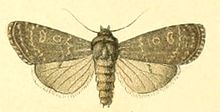This article has multiple issues. Please help improve it or discuss these issues on the talk page. (Learn how and when to remove these template messages)
|
Euxoa birivia is a moth of the family Noctuidae. It is found in Europe (France, Italy, Germany, Switzerland, Austria, Poland, Czech Republic, Slovakia, Hungary, Romania, Albania, Slovenia, Bosnia and Herzegovina, Bulgaria and Croatia), east to Ukraine, the Caucasus, Armenia, central Asia, Ili, Issyk-Kul, Turkey and Iran.
| Euxoa birivia | |
|---|---|

| |
| Female | |

| |
| Male | |
| Scientific classification | |
| Domain: | Eukaryota |
| Kingdom: | Animalia |
| Phylum: | Arthropoda |
| Class: | Insecta |
| Order: | Lepidoptera |
| Superfamily: | Noctuoidea |
| Family: | Noctuidae |
| Genus: | Euxoa |
| Species: | E. birivia
|
| Binomial name | |
| Euxoa birivia (Denis & Schiffermüller, 1775)
| |
| Synonyms | |
| |
Description edit
The wingspan is 34–41 mm. Warren states E. birivia Schiff. (= honoratina Donz., dolis Grote) (6c). Forewing dark ashgrey, with pale dusting;lines themselves ill-defined , but marked by paler scaling ; orbicular and reniform stigmata ochreous , or with the centres dark but ringed with ochreous; hindwing fuscous grey, paling towards base. Occurs in S. Europe, in the French and Swiss Alps, in Italy,, Austria and Hungary; — in the ab. taurica Stgr. the pale scales are ochreous yellow, instead of white; this form occurs in Asia Minor and Turkestan.[1]
Biology edit
Adults are on wing from mid July to the end of August. There is one generation per year.
The larvae probably feed on the roots of various grass species.
References edit
- ^ Warren, W. in Seitz, A. Ed., 1914 Die Großschmetterlinge der Erde, Verlag Alfred Kernen, Stuttgart Band 3: Abt. 1, Die Großschmetterlinge des palaearktischen Faunengebietes, Die palaearktischen eulenartigen Nachtfalter, 1914 This article incorporates text from this source, which is in the public domain.
External links edit